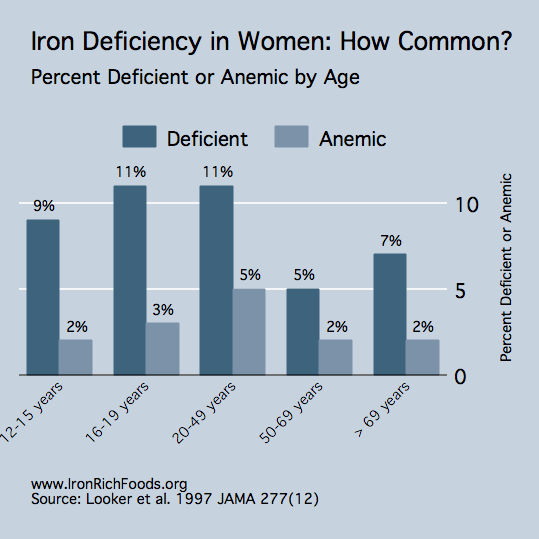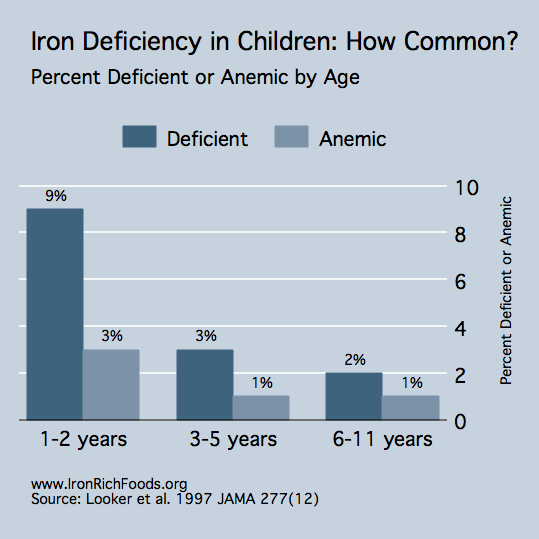Iron rich foods are an important part of human health because of the extreme health consequences of iron deficiency. An iron deficient person may experience fatigue, mental decline, and paleness. In children, physical and mental growth may be stunted. The consequences of iron deficiency have been well-known for some time. The prevalence of iron deficiencies in the United States have been acknowledged in the scientific literature for over fifty years. Public health programs have focused on improving the iron status of vulnerable populations, notably infants and toddlers as well as young women (and, in particular, pregnant women). Foods packed with iron are key in this fight.
Dietary Intake and Iron Deficiency
 A 1997 study of the iron status of the U.S. population found that iron deficiency continued into the 1990s. Researchers used extensive survey data funded by the government and conducted by the USDA that measures food intake and catalogs the medical exams of participants. In this case, researchers were able to examine blood tests of participants and determine if they were iron deficient or, worse yet, had developed iron deficiency anemia, a condition preventable with foods high in iron.
A 1997 study of the iron status of the U.S. population found that iron deficiency continued into the 1990s. Researchers used extensive survey data funded by the government and conducted by the USDA that measures food intake and catalogs the medical exams of participants. In this case, researchers were able to examine blood tests of participants and determine if they were iron deficient or, worse yet, had developed iron deficiency anemia, a condition preventable with foods high in iron.
Nine percent (9%) of children up to age two were iron deficient; 3% were anemic. Deficiency rates among men were low, but about ten percent of women from puberty to menopause were deficient in iron; about 3% were anemic. However, iron deficiency and iron deficiency anemia are more common among poor populations. African American and Mexican American populations tend to suffer disproportionately as well and would benefit from a high iron diet.
Iron Foods or An Iron Supplement?
 To respond to iron deficiency in children, infant and toddler formulas and other foods are fortified with iron. Infants are often prescribed an iron supplement from their pediatrician. In pregnancy, iron levels are monitored closely by the obstetrician or midwife providing the patient care and iron supplements are recommended or prescribed if need be. (Read more about iron rich foods in pregnancy.)
To respond to iron deficiency in children, infant and toddler formulas and other foods are fortified with iron. Infants are often prescribed an iron supplement from their pediatrician. In pregnancy, iron levels are monitored closely by the obstetrician or midwife providing the patient care and iron supplements are recommended or prescribed if need be. (Read more about iron rich foods in pregnancy.)
Iron supplementation is the fastest and most effective way to improve your iron status and should be a part of the toolkit of any person suffering from iron deficiency, particularly if combined with an iron rich diet. Not only are there supplements that supply you with additional iron, but there are supplements that help you absorb more of the iron you are already consuming and, perhaps, build your immune system at the same time. Check out our recommended best iron supplement.
Foods High In Iron For The Long Game
For the long term, it is important to improve your diet to include more foods with iron that is highly absorbed or by using kitchen preparation techniques to unlock the iron from your food. Here at dailyiron.net we provide an extensive collection of information on improving your iron status through foods, including our five top tricks to improve your food iron through basic preparation techniques. We make use of the extensive data collection provided by the USDA on the nutrient content of food.
Meats
Meat is rich in iron, particularly in red meat and meat products (such as sausage) that contain red meat. People who consume red meat regularly tend not to develop iron deficiency in the first place because of the high iron content in the food. Read more about meat foods high in iron. We strongly encourage people looking for high iron foods to consider red meat, even in small amounts because it will increase your overall absorption of iron.
Beans
Beans are on the list of foods high in iron. However, they do contain iron inhibitors and you will get far more iron out of them if you soak them (as per the instructions on this site) and eat them with complementary foods. Read more about beans. You can find detailed food science on soaking beans at our sister site. You might also read more about phytic acid, a key compound that inhibits your absorption of iron in food.
Grains
Grains can be an important source of iron in a plant-based diet and are iron rich, but they do have iron inhibitors that demand you pay close attention to how you prepare them for your meals. It is important that you focus on soaking grains before cooking them. Soak them in warm water for eight to twelve hours to reduce their phytic acid content. If you reduce the phytic acid, you will absorb more iron in your grain-based foods. Read more about these foods high in iron — grains.
Fruits and Vegetables
Vegetables and fruits are a poor source of iron in themselves, but vegetables and fruits do provide vitamin C which can help you improve your absorption of iron even if they are not iron-rich. Vitamin C in a meal does help you absorb more on the iron in plant-based foods that is otherwise inhibited by substances such as phytic acid. Vitamin C in fruits and vegetables is an important tool in the iron-rich fruits and vegetables arsenal. Read more about vegetables and fruits.
Iron Rich Recipes
Throughout this site you will find iron-rich recipes but the most interesting you will find popping up on the blog, along with articles of interest to those deficient in iron.